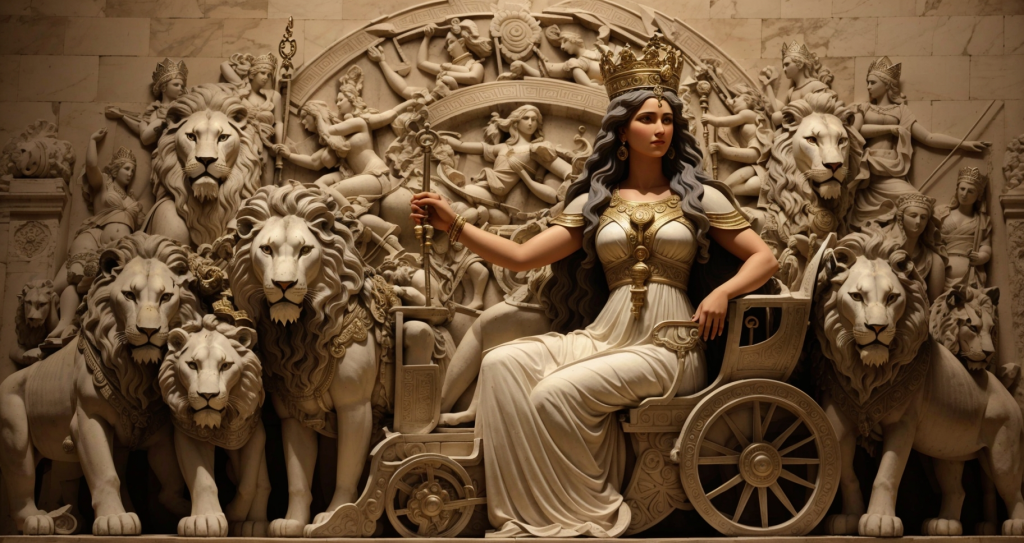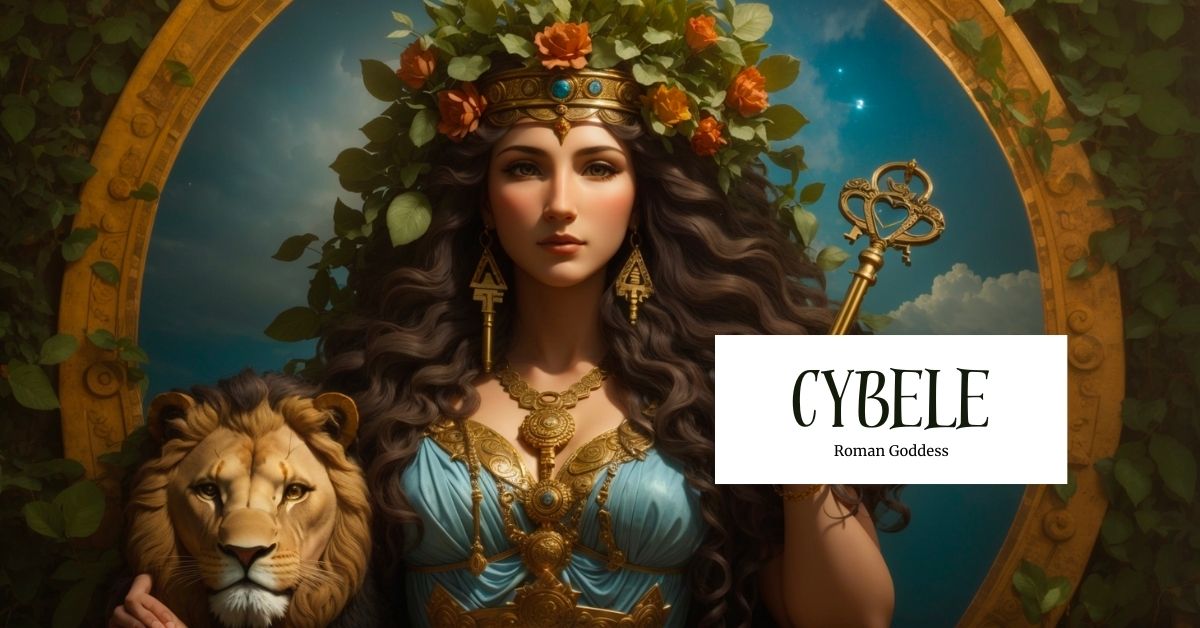Cybele: The Mother Goddess
Cybele, the Roman goddess of fertility and nature, holds a place of profound intrigue and enigma within ancient mythology. Unlike many of the major Roman deities we know today, Cybele was not taken from the Greeks. Instead her roots come from Anatolia, in the ancient Phrygian culture.
Overview of Cybele
Cybele, the Roman goddess of fertility and nature, originated from Phrygia (modern-day Turkey) and was assimilated into the Roman pantheon during ancient times.
Known as Magna Mater or the Great Mother, she symbolized the Earth’s life-giving force and was often depicted as a seated goddess wearing a crown. Her worship involved extravagant rituals performed by eunuch priests called Galli, who engaged in frenzied dances during festivals.
Cybele’s association with the god Attis (discussed below) highlighted the cycle of life and the seasonal changes of nature. Her influential cult and festivals, such as the Megalesia, left a lasting impact on Roman religious practices and her role as a nurturing and protective deity.
Often depicted as a regal figure, Cybele exuded both maternal warmth and commanding authority. Lions, symbolic of her connection to the wild, were often intertwined with her imagery. The worship of Cybele was characterized by mysterious cults and lavish rituals.

Source: The Met
Titles
- Great Mother
- Magda Mater (“Great Mother” in Latin, a title used during her worship in Rome.)
- Mother of the Gods
- Mountain Mother
- Cybele of the Lions
- Mistress of Animals
- Phrygian Mother
Abilities
Cybele, the Roman goddess of fertility and nature, possessed a range of abilities and attributes that established her as a powerful and revered deity. Her foremost ability was to bestow fertility and abundance upon the land, crops, and livestock, much like fellow Roman Goddess, Ceres.
As the embodiment of the Earth’s life-giving force, Cybele had the power to nurture and sustain all living beings. She was also associated with the protection of wild animals, symbolizing her dominion over the untamed forces of nature. Cybele’s influence extended beyond the natural realm, as she was believed to have the ability to grant prosperity, abundance, and protection to her worshippers.
Notably, Cybele was associated with the cycles of life, death, and rebirth, reflecting her connection to the perpetual renewal of nature. Through her abilities, Cybele played a pivotal role in ensuring the well-being and continuity of life, both in the human and natural realms.
Characteristics
Cybele possessed a commanding and regal presence that captivated the imagination of her worshippers. Often depicted as a majestic figure seated upon a throne, she exuded an aura of authority and maternal warmth.
Her physical appearance reflected her divine stature, with a crown adorning her head as a symbol of her power and majesty.
Cybele’s countenance radiated a serene and nurturing grace, embodying the essence of motherhood. She was often depicted with flowing robes, representing her connection to the Earth and the abundance of nature. Her gaze held a mixture of wisdom and compassion, embodying her role as the guardian and protector of all life.

Source: Tornos News
This 2,100 year old marble statue of Cybele was discovered in Ordu, Turkey, where Cybele was once revered as the Anatolian mother goddess. Cybele symbolizes the prosperity of the Earth as she sits upon a throne with a pregnant belly.
Traits
Cybele’s cult celebrated her as a deity of abundance, prosperity, and renewal, highlighting her transformative nature. She was revered as a nurturing and maternal figure, embodying the essence of motherhood and the protective instincts associated with it.
Cybele exhibited both strength and regality, commanding respect and authority. Her connection to the Earth and the natural world gave her a grounded and stabilizing presence, yet with her wild and untamed aspects, she represented the powerful forces of nature.
Symbols
Cybele was accompanied by a range of symbols that represented her essence and power. Lions, as her primary sacred animal, symbolized her strength, majesty, and connection to the wild. They were often depicted by her side, emphasizing her dominion over the animal kingdom.
The crown or mural crown, worn atop her head, symbolized her regal authority and status as a revered deity.
In her depictions, Cybele often held a key, signifying her power as the gatekeeper to the mysteries of life and death.
She was also associated with the lion-drawn chariot, shown below. This highlighted her role as a divine charioteer traversing the realms of existence.
Additionally, the tympanum, a round frame drum, was closely linked to her worship, representing both the rhythmic heartbeat of life and the ecstatic music and dance that accompanied her rituals.
Cybele’s symbols collectively conveyed her qualities of power, wildness, authority, mysticism, and the pulsating rhythms of life, making them integral to her worship and visual representations.

Source: The Met
This ancient Roman artifact from the mid-imperial period depicts Cybele on a cart drawn by lions, demonstrating her regality and connection to the wilderness.
Festivals and rituals
Cybele was honored through a series of festivals and rituals that showcased the grandeur and devotion surrounding her worship.
One of the most renowned celebrations was the Megalesia, held in Rome from April 4th to April 10th. This festival included magnificent processions, theatrical performances, and chariot races in honor of Cybele.
The Galli, the eunuch priests of Cybele, played a central role in the rituals. They engaged in frenzied dances and self-flagellation, accompanied by the resonating sounds of drums and cymbals, in ecstatic displays of devotion. The festival also featured dramatic reenactments of myths associated with Cybele, such as the story of Attis, which we will dive into below.
These rituals aimed to celebrate her power, ensure the prosperity of the city, and invoke her blessings for fertility and abundance.
Legends associated with Cybele
We discuss a few selected legends that surround Cybele which explore her divine origins, intricate relationships, and enduring symbolism as the Great Mother.
Origin story
The origin story of Cybele is rooted in ancient Phrygian mythology. Legend has it that she emerged from the Earth itself, born of the sacred rock known as the “Phrygian stone.”
As a powerful and maternal figure, Cybele symbolized the life-giving force of the Earth and embodied the primordial essence of creation. Her divine presence captivated all who beheld her, radiating both regal authority and nurturing warmth.
With her origins deeply intertwined with the Earth, Cybele became a revered deity associated with fertility, abundance, and the natural world. This lays the foundation for her role as the Great Mother, guiding and sustaining life in all its forms.
Cybele’s journey from her Phrygian origins to her assimilation into Roman society is a testament to the cultural exchange and religious syncretism of the ancient world.
As Rome expanded its influence, it encountered and embraced the worship of various deities from conquered regions. Cybele, with her powerful association with fertility and nature, captivated the Romans, who recognized parallels between her and their own goddesses.
Cybele and Attis
The most popular legend of Cybele involves the story of her relationship with Attis, a handsome young shepherd. According to the myth, Cybele fell deeply in love with Attis and bestowed upon him great beauty and talents. However, their relationship faced a tragic twist when Attis became unfaithful to Cybele.
In her fury and grief, Cybele cursed Attis, driving him into a state of madness. In his delirium, Attis castrated himself under a pine tree. The remorseful Cybele, realizing the consequences of her anger, transformed Attis into an evergreen pine tree, symbolizing eternal life. The Tree of Life is a powerful symbol that goes across cultures and civilizations. This act represented the cyclical nature of life, death, and rebirth associated with Cybele, as well as the evergreen pine’s connection to fertility and immortality.
This legend of Cybele and Attis is often seen as a metaphorical representation of the changing seasons, with Attis’s castration symbolizing the barrenness of winter and his transformation into a pine tree representing the renewal and vitality of spring. It is also interpreted as an allegory of the goddess’s power, passion, and the potential destructive consequences of love and desire.
The sacred stone
Another of Cybele’s legends begins in the ancient city of Pessinus, where there was a sacred stone believed to embody Cybele. It fell from the heavens and was revered as a symbol of her power. The stone was brought to Rome during the Second Punic War, and its arrival was seen as a sign of divine favor. It became a centerpiece of worship and protection in Rome, symbolizing the connection between the city and Cybele.
Cybele and Claudia Quinta
In another Roman myth, Claudia Quinta, a noblewoman devoted to the worship of Cybele, was falsely accused of unchastity. In her desperation, she prayed to Cybele for help. Miraculously, a magnificent statue of Cybele arrived, carried by lions. The lions knelt before Claudia, proving her innocence and restoring her honor. This event affirmed the power of faith and Cybele’s intervention in the lives of her followers.

Source: Leonardo.ai
Influences of other religions/cultures on Cybele
The ancient Anatolian goddess, experienced significant influence from various religions and cultures throughout history. As her worship spread, she absorbed elements from different traditions, adapting and evolving over time. For instance, the Phrygians, Greeks, and Romans all contributed to her mythology, iconography, and rituals.
The Phrygian influence brought the worship of a Mother Goddess figure associated with fertility and the harvest. Greek mythology intertwined Cybele with the Titan goddess Rhea, emphasizing her motherly aspects.
The Romans, upon adopting her cult, identified her with their own goddess Magna Mater, or “Great Mother.” Moreover, as the Roman Empire expanded, Cybele’s worship interacted with local religions, incorporating regional customs and practices.
The expansion of the Roman Empire also introduced Cybele to the Eastern Mediterranean and North Africa, where she encountered the religious beliefs and practices of various cultures. This led to further syncretism, blending Cybele’s attributes with local deities and customs. For example, in Egypt, she was associated with the goddess Isis, while in Phoenicia, she merged with Astarte.
This amalgamation of diverse beliefs and cultural exchanges showcases the syncretic nature of Cybele’s cult, illustrating how she absorbed and adapted to various religious and cultural influences over time.
The spread of the cult of Cybele throughout the empire brought about the construction of grand temples, such as the Magna Mater Temple in Rome. These temples served as centers of devotion and pilgrimage, attracting worshippers from diverse backgrounds and promoting a multicultural religious experience.
Modern appearances
The fantasy novel, Cybele’s Gift by Juliet Marillier, weaves elements of Cybele’s mythology into a tale of adventure and romance. It follows the journey of a young woman who discovers her connection to the goddess and must navigate the challenges that arise.
Final thoughts
Cybele embodies a many attributes that continue to resonate in our modern world. Her mythology and symbolism encompass the potent forces of nature, fertility, and the nurturing power of the divine feminine.
She represents the cyclical nature of life, death, and rebirth, reminding us of the eternal rhythms that govern our existence.
Represented as a guardian of the Earth and its creatures, Cybele inspires reverence for the natural world and encourages sustainable practices.
Her presence invites us to embrace our interconnectedness with the Earth and honor the intrinsic power of femininity. In an ever-changing world, Cybele stands as a timeless embodiment of strength, regeneration, and the beauty found in the cycles of life.
References
Beard, M., North, J., & Price, S. (1998). Religions of Rome: A History. Cambridge University Press.
Dillon, M., & Garland, L. (Eds.). (2005). Ancient Rome: From the Early Republic to the Assassination of Julius Caesar. Routledge.
Fowler, W. W. (2004). Roman Religion: From its Origins to the End of the Republic. Routledge.
Roller, Lynn. In Search of the God Mother: The Cult of Anatolian Cybele. 1999.
Scheid, John. “An Introduction to Roman Religion.” Indiana University Press, 2003.







